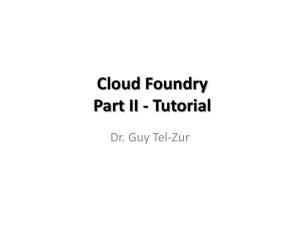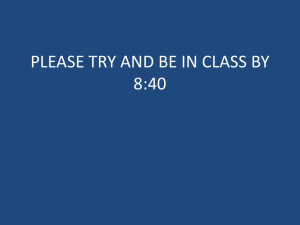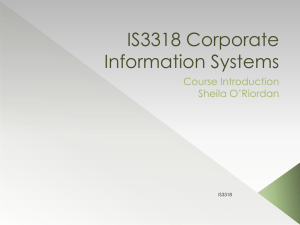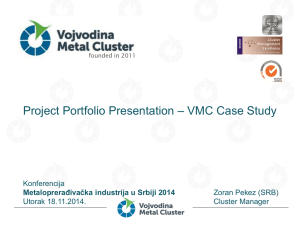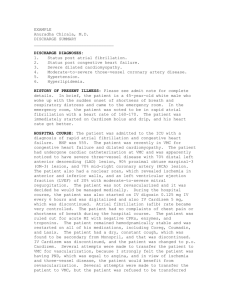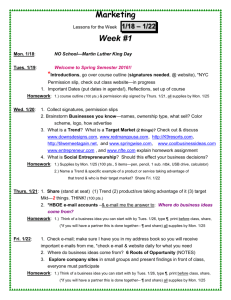Databases, Information and Conceptual Schema
advertisement
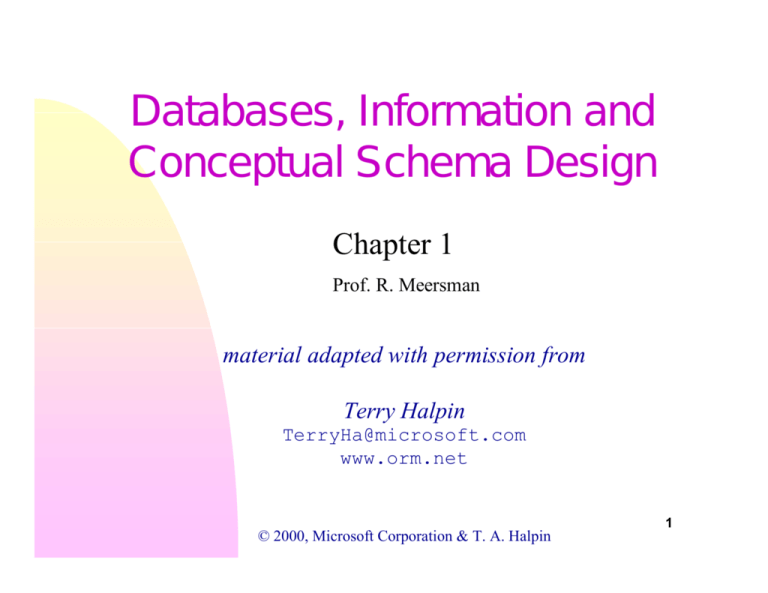
Databases, Information and
Conceptual Schema Design
Chapter 1
Prof. R. Meersman
material adapted with permission from
Terry Halpin
TerryHa@microsoft.com
www.orm.net
© 2000, Microsoft Corporation & T. A. Halpin
1
Information systems modeling
ORM (Object Role Modeling): conceptual schema design
ER (Entity Relationship) and UML (Unified Modeling Language)
ORM: mapping from conceptual to relational
ORM: schema equivalence and optimization
2
Information systems modeling
• The two fundamental skills
• Information systems development:
– life cycle
– perspectives, levels, worlds
– frameworks
• Five language generations
• Information modeling methods
3
Movie
Year
Director
Stars
Awakenings 1991 Penny Marshall Robert De Niro
Robin Williams
Backdraft
1991 Ron Howard
William Baldwin
Robert De Niro
Kurt Russell
Cosmology 1994 Terry Harding
Dances with 1990 Kevin Kostner Kevin Kostner
wolves
Mary McDonnell
An output report (external level)
4
Movie: movieName
releaseYr
director
star
Awakenings
1991
Penny Marshall
Robert De Niro
Awakenings
1991
Penny Marshall
Robin Williams
Backdraft
1991
Ron Howard
William Baldwin
Backdraft
1991
Ron Howard
Robert De Niro
Backdraft
1991
Ron Howard
Kurt Russell
Cosmology
1994
Terry Harding
Dances with wolves
1990
KevinKostner
Kevin Kostner
Dances with wolves
1990
KevinKostner
Mary McDonnell
?
A relational database table.
Is anything wrong?
5
Movie:
Starred:
movieName
Awakenings
Backdraft
Cosmology
Dances with wolves
m ovieN am e
A wakenings
A wakenings
B ackdraft
B ackdraft
B ackdraft
D ances with wolves
D ances with wolves
releaseYr
1991
1991
1994
1990
director
Penny Marshall
Ron Howard
Terry Harding
Kevin Kostner
star
R obert D e N iro
R obin W illiam s
W illiam B aldwin
R obert D e N iro
K urt R ussell
K evin K ostner
M ary M cD onnell
6
The implemented database design should:
• correctly model your business
• completely model those aspects of interest
• efficiently model your business
Uncontrolled redundancy can lead to
inconsistency
inefficiency
7
Movie ( movieName, releaseYr, director )
Starred ( movieName, star )
Consider the following English query:
For each movie, list its name, director
and stars (if any).
How can we say this in SQL
(a relational query language)?
8
Movie:
Starred:
moviename
Awakenings
Backdraft
Cosmology
Dances with wolves
movieName
Awakenings
Awakenings
Backdraft
Backdraft
Backdraft
Dances with wolves
Dances with wolves
releaseyr
1991
1991
1994
1990
director
Penny Marshall
Ron Howard
Terry Harding
Kevin Kostner
star
Robert De Niro
Robin Williams
William Baldwin
Robert De Niro
Kurt Russell
Kevin Kostner
Mary McDonnell
select Movie.movieName, director, star
from Movie, Starred
where Movie.movieName = Starred.movieName
Is this OK?
9
Movie:
Starred:
movieName
Awakenings
Backdraft
Cosmology
Dances with wolves
movieName
Awakenings
Awakenings
Backdraft
Backdraft
Backdraft
Dances with wolves
Dances with wolves
releaseYr
1991
1991
1994
1990
director
Penny Marshall
Ron Howard
Terry Harding
Kevin Kostner
star
Robert De Niro
Robin Williams
William Baldwin
Robert De Niro
Kurt Russell
Kevin Kostner
Mary McDonnell
select Movie.movieName, director, star
from Movie left outer join Starred
on Movie.movieName = Starred.movieName
10
Two fundamental human skills
• describe the universe of discourse
• query the system about the UoD
11
“ORM lifts our thinking up so we can model
and query the world at the conceptual level” [Halpin 2000]
12
Procedure:
Information systems life cycle
• Feasibility study
• Requirements analysis
• Conceptual design (data, process)
• Logical design (data, process)
• External design (data, process)
• Prototyping
• Internal design and implementation
• Testing, validation and maintenance
Large projects are often developed iteratively
13
This high level cycle can be fleshed out with many
detailed procedures for each phase
(e.g. ORM CSDP).
The rise of component technology, design patterns
and ERP packages has seen a move
from
“Build or Buy”
to
“Build and Buy and Reuse”1
1e.g.
see ERP articles in CACM, April 2000
14
2 main Perspectives: Data
Process1
-- what information
-- how it is used
In the 70s, IS modeling was typically process-driven.
But for database applications, data structures were more central
and more stable than processes. And refining processes into
data-structures was too laborious.
So data-driven approaches became more widely used.
Current modeling approaches are often partly process-driven
and partly data-driven. Data and process modeling can be
done in tandem or parallel, with cross-checks for consistency
and completeness.
1 The
following IFIP study added Behavior as 3rd perspective, but with no clear distinction between process and
behavior: Olle et al. 1991, Information Systems Methodologies: a Framework for Understanding, 2nd edn,
Addison-Wesley.
15
4 Levels: 4 schemas
1.Conceptual
human-oriented
natural language
elementary facts
implementation-independent
most stable
e.g. true ER, ORM, some of UML
2.Logical
commit to underlying model type
e.g. relational, hierarchic, network,
ODMG Object model,
SQL:1999 Object-Relational
compound facts (normally)
DBMS-independent (within model type)
Many commercial ERs are mainly at this level,
e.g. IDEF1X
16
3.Internal
physical implementation model actually used to
store data
execute operations
(add, delete, edit, read, navigate)
indexes, pointers, clustering etc.
e.g. an SQL Server database
4.External
user interfaces
e.g. forms, reports for a specific user-group
interfaces may differ in:
content (data, operations)
display (format, help etc.)
usage (mouse, key etc.)
17
4 worlds1
Subject world
universe of discourse (UoD)
= application domain
System world
the information system’s formal model
of the application domain
(“dry”)
Usage world
(“wet”)
Development world
the world in which the system is to function,
including user community, user interfaces etc.
(a.k.a. environment of discourse)
environment and processes used to develop
the system, including modelers, programmers,
design methods, project schedules etc.
1Jarke
M., Mylopoulos J. &Vassiliou, Y. 1992, ‘DAIDA: an environment for evolving information systems’,
ACM TODS, vol. 10, no. 1, pp. 1-50.
18
“6 perspectives”
“I keep six honest serving friends …
Their names are
What
and
Why
and
When
and
How
and
Where
and
Who”
1Kipling,
R. 1902, “The Elephant’s Child”
19
Levels + perspectives
A number of 2-dimensional frameworks have been proposed
using the dimensions of Level and Perspective.
The most influential has been the Zachman Framework1.
This has 5 levels and 6 perspectives, resulting in 30 cells.
It is promoted by the Zachman Institute for Framework
Advancement (ZIFA)2.
Any systems engineering project needs to consider:
Which cells are relevant?
How do we map between levels?
1Zachman,
J. 1987, ‘A framework for information systems architecture’, IBM Systems Journal, vol. 26, no. 3.
2www.zifa.com
20
Zachman Framework for Enterprise Architecture
data
what
function
how
network
where
people
who
time
when
motivation
why
scope
enterprise
model
system
model
technology
model
detailed
representation
21
Level/Focus: 4x6
Data
(what)
Process
(how)
Deployment
(where)
People
(who)
Time
(when)
Motivation
(why)
Conceptual
Logical
Physical
External
Such a 2-D grid is useful as an organizational overview.
Add guidelines for deciding:
which cells to use?
which tools to use for each cell?
which tools to use for mapping?
22
Abstraction
For a given purpose:
Show all relevant detail
Hide unwanted detail
Levels and perspectives are abstraction mechanisms.
There are many others,
e.g.
step-wise refinement (e.g. within a cell)
object-type zoom
paging
layering/toggles
componentization
23
The data model and query design should be:
performed at the conceptual level;
then mapped to the other levels.
This vastly simplifies:
getting it right in the first place;
making changes later as the business evolves
24
Movie
Year
Director
Stars
Awakenings 1991 Penny Marshall Robert De Niro
Robin Williams
Backdraft
1991 Ron Howard
William Baldwin
Robert De Niro
Kurt Russell
Cosmology 1994 Terry Harding
Dances with 1990 Kevin Kostner Kevin Kostner
wolves
Mary McDonnell
external level
25
ORM:
was released in
Year
(AD)+
was directed by/ directed
Movie
(name)
Person
(name)
starred
26
RDB:
Movie ( movieName, releaseYr, director )
Starred ( movieName, star )
ORDB:
Movie ( movieName, releaseYr, director, {star} )
27
English:
For each movie, list its name,
who directs it
and who (if anybody) stars in it.
ConQuer:
Movie
was directed by Person1
possibly starred Person2
RIDL:
for Movie list (Name of it, Person
directing it, Person starring_in it)
28
5 generations of computer languages
Generation Language
example
5
ConQuer
Sample code for same task
Planet that has Mass
and possibly is orbited by Moon
4
SQL
select X1.planetName, X1.mass, X2.moonName
from Planet as X1 left outer join Moon as X2
on
3
Pascal
X1.planetName = X2.planetName
Two pages of instructions like:
for i := 1 to n do begin
write (planetName[i], mass[i]);
2
8086
Many pages of instructions like:
Assembler
ADDI AX, 1
1
8086
machine
code
Many pages of instructions like:
00000101 00000001 00000000
29
Information modeling methods
Method = Language(s) + Procedure(s)
Language (Notation)
Informal
Structured
No formal syntax Formal syntax
e.g.
e.g.
cartoons
most DFDs
natural language some DSDs
Formal
Formal syntax and
Formal semantics
e.g.
predicate calculus
Petri nets
Z
FORML, ConQuer
30
Language
Graphical
Textual
Intuitive
Sometimes natural
Fast communication
Slower communication
Limited expressive power
Usually more expressive
Often best to use a combination of languages
Design procedures:
Very important in practice
Too often neglected
31
Conceptual modeling language criteria
Expressibility
Clarity
Simplicity and orthogonality
Semantic stability
Semantic relevance
Validation mechanisms
Abstraction mechanisms
Formal foundation
32
ER and UML
ORM
World
view
entities that
have attributes and
participate in
relationships
objects that
play roles
Graphical
language
rectangles
diamonds and lines
etc.
ellipses
role boxes
etc.
ORM ‘s avoidance of attributes has many advantages,
e.g. stability, populability, verbalization, no null values
33
Modeling perspectives:
data
process
…
(what facts)
(how)
OO approaches often claim to unify data and process modeling.
They have not yet done so
e.g. weak links between use cases, classes and activities.
Modeling method = notation (language) +
procedures for developing models.
UML advocates a
“use-case driven,
architecture-centric,
iterative approach”.
34
UML use cases are …
Cases of the information system being used
Useful for requirements analysis
Typically focused on process modeling
Offer only limited help for data modeling
35
ATM
Produce account
balance
Going from a
(process) use case
to a data model
Process Deposit
Client
Process withdrawal
Bank
uses /is used by
Client
(clientNr)
Account
(nr)
u
AccountType
(code)
holds
has
involves
MoneyAmt
(usd)+
is on
Transaction
(nr)
is of
TranType
(code)
36
For data modeling we need “data use cases”
i.e. cases (examples) of data being used
e.g. sample output reports, input forms/screens
Room
20
20
33
33
…
Time
Mon 9 am
Tue 2 pm
Mon 9 am
Fri 5 pm
…
ActivityCode
VMC
VMC
AQD
SP
…
ActivityName
VisioModeler class
VisioModeler class
ActiveQuery demo
Staff party
…
How do we model this report?
37
IDEF1X
Room
Time
20
20
33
33
…
Mon 9 am
Tue 2 pm
Mon 9 am
Fri 5 pm
…
ActivityCode
VisioModeler class
VisioModeler class
ActiveQuery demo
Staff party
…
VMC
VMC
AQD
SP
…
Activity
RoomSchedule
roomNr
timeCode (AK1)
ActivityName
activityCode
has /
is of
activityName (AK1)
activityCode (FK, AK1)
Relational
RoomSchedule
PK
PK, U1
FK, U1
roomNr
timeCode
Activity
PK
activityCode
U1
activityName
activityCode
38
Room
Time
20
20
33
33
…
Mon 9 am
Tue 2 pm
Mon 9 am
Fri 5 pm
…
ActivityCode
VMC
VMC
AQD
SP
…
ActivityName
VisioModeler class
VisioModeler class
ActiveQuery demo
Staff party
…
Barker ER
ROOM TIME SLOT
of
# * time
ROOM
within
booked
for
# * roomNr
...
ACTIVITY
allocated # * activityCode
* activityName
Missing constraints?
39
Room
Time
20
20
33
33
…
Mon 9 am
Tue 2 pm
Mon 9 am
Fri 5 pm
…
UML
ActivityCode
ActivityName
VisioModeler class
VisioModeler class
ActiveQuery demo
Staff party
…
VMC
VMC
AQD
SP
…
Time
dhCode {P}
*
Room
Activity
0..1
0..1
roomNr {P}
activityCode {P}
activityName {U1}
Usage
40
Room
Time
20
20
33
33
…
Mon 9 am
Tue 2 pm
Mon 9 am
Fri 5 pm
…
ActivityCode
VMC
VMC
AQD
SP
…
?
ActivityName
VisioModeler class
VisioModeler class
ActiveQuery demo
Staff party
…
Time
dhCode {P}
*
Room
0..1
0..1
roomNr {P}
Activity
activityCode {P}
activityName {U1}
Usage
We need a practical procedure for
• abstracting from data use cases to the data model
• validating the data model
41
The domain expert best understands the application
domain, so should play an active role in
modeling sessions.
The modeler’s main task is to formalize the domain
expert’s informal knowledge.
42
Communication
between modeler
and domain expert
should:
•
Verbalize fact instances from data use cases
•
Verbalize fact types in natural language
•
Validate rules in natural language
•
Validate rules using sample populations
43
Object Role Modeling (ORM)
Understandable
Express facts and rules in English
and/or intuitive graphics
Reliable
Validate rules using English
and sample populations
(multiple instances)
Expressive
Capture more business rules
graphically
Stable
Minimize the impact of change
to models and queries
ORM may be used instead of, or prior to, other approaches
44
Fact Orientation
Data examples are expressed as elementary facts
in English sentences.
How facts are grouped into structures
(e.g. R-tables, OR-tables, Object classes)
is not a conceptual issue.
Fact-orientation is at a conceptual level
above object-orientation.
This is where modeler and domain expert should
communicate and validate their understanding.
45
Fact structure notations
ORM
UML
ER
Object class
Entity type
Data type
Value type
-- *
Attribute
Attribute
Unary relationship
-- **
--**
2+-ary relationship
Association
Often binary only
Objectified relationship
Association class
--
Co-reference
Qualified assoc. §
--
Object type: Entity type
Value type
* use relationship
** use Boolean attribute
§ incomplete coverage
46
Role and Object: unifying concepts
ORM’s concept of a Role unifies UML’s concept of
AssociationEnd with the notion of an attribute,
resulting in a notation that is:
simpler
more orthogonal
more expressive
ORM’s concept of Object unifies entities and values
47
“The Telephone Heuristic”
Room
20
20
33
33
…
Time
Mon 9 am
Tue 2 pm
Mon 9 am
Fri 5 pm
…
ActivityCode
VMC
VMC
AQD
SP
…
ActivityName
VisioModeler class
VisioModeler class
ActiveQuery demo
Staff party
…
ORM CSDP
Step 1a: verbalize (domain expert)
Step 1b: verbalize as elementary facts
(modeler)
48
Ternary Facts
Room
20
…
Time
Mon 9 am
…
ActivityCode
VMC
…
ActivityName
VisioModeler class
…
Fact 1:
Room ‘20’
at
Time ‘Mon 9am’
is booked for
Activity ‘VMC’
Fact type:
Room at Time is booked for Activity
Predicate:
…at ... is booked for ...
49
Ternary Fact Type
Time
(dh)
Room
(nr)
Activity
(code)
... at ... is booked for ...
Sample population
(positive):
Verbalize constraints (+ve):
20
20
33
33
...
Mon 9am
Tue 2 pm
Mon 9 am
Fri 5pm
...
VMC
VMC
AQD
SP
...
Given any Room and Time,
that Room at that Time is booked for at most one Activity.
Given any Time and Activity,
at most one Room at that Time is booked for that Activity.
50
Verbalize default (lack of constraint):
(no UC over Room-Activity)
Time
(dh)
Room
(nr)
Activity
(code)
... at ... is booked for ...
20
20
33
33
...
Mon 9am
Tue 2 pm
Mon 9 am
Fri 5pm
...
VMC
VMC
AQD
SP
...
it is possible that
the same Room at more than one Time is booked for the same Activity
51
Negative verbalization and counter-examples:
It is impossible that the same Room at the same time Time
is booked for more than one Activity
Time
(dh)
Room
(nr)
Activity
(code)
... at ... is booked for ...
20
20
33
33
...
20
Mon 9am
Tue 2pm
Mon 9am
Fri 5pm
...
Mon 9am
VMC
VMC
AQD
SP
...
AQD ?
52
It is impossible that more than one Room at the same Time
is booked for the same Activity
Time
(dh)
Room
(nr)
Activity
(code)
... at ... is booked for ...
20
20
33
33
...
33
Mon 9am
Tue 2pm
Mon 9am
Fri 5pm
...
Mon 9am
VMC
VMC
AQD
SP
...
VMC ?
53
Binary Facts
Room
20
…
Time
Mon 9 am
…
ActivityCode
VMC
…
ActivityName
VisioModeler class
…
Fact 2:
Activity ‘VMC’
has
ActivityName ‘VisioModeler class’
Fact type:
Activity has ActivityName
Predicate:
…has ...
54
Binary Fact Type
has /refers to
Activity
(code)
ActivityName
VMC
AQD
SP
…
VisioModeler class
ActiveQuery demo
Staff Party
...
each Activity has exactly one ActivityName
each ActivityName refers to at most one Activity
55
Time
(dh)
Room
(nr)
Activity
(code)
... at ... is booked for ...
ActivityName
has /refers to
20
Mon 9am
VMC
AQD
ActiveQuery demo
20
Tue 2pm
VMC
SP
Staff party
33
Mon 9am
AQD
VMC
VisioModeler class
33
...
Fri 5pm
...
SP
…
Y2K
...
Year 2000 seminar
...
Extra data may be needed to illustrate some constraints
56
Terminator 2
Crocodile Dundee
Backdraft
USA
Aus
USA
originated in
Movie
(name)
Country
(code)
SalesLevel
(name)
the export of ... to ... achieved ...
Backdraft
Backdraft
Backdraft
Crocodile Dundee
Crocodile Dundee
Aus
NZ
UK
NZ
USA
{'high','medium','low'}
high
low
medium
low
high
57
earns /is earned by
PhoneNr
connectedness
Employee
Name
Salary
(usd)+
has
Color
(name)
Car
(regnr)
is of
CarModel
(name)
drives /is driven by
has
main-
has
other-
has
speaks /is spoken by
reports
to
oac
Language
(name)
Employee
(nr)
supervises
is used in
was born in /is birthplace of
clarity
uses
works
for
heads
is headed by
employs
Country
(name)
lives in
Statecode
is located in /is location of
City
Branch
(nr)
u
is
in
has
is
in
has
u
expressibility
USbranch
Cityname
...
achieved
...
in
...
Rank
(nr)
Year
(AD)+
State
* define Branch is in Country as
Branch is located in a City
that is in a State
that is in Country
* each USbranch is a Branch
that is in Country 'USA'
58
